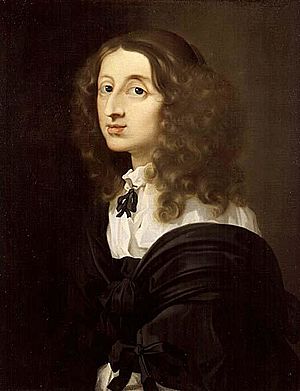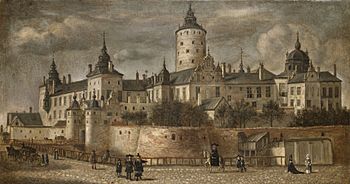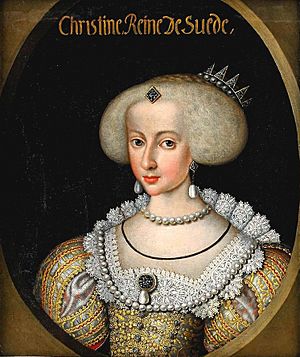Christina, Queen of Sweden facts for kids
Quick facts for kids Christina |
|||||
|---|---|---|---|---|---|

Portrait by Sébastien Bourdon, who
exaggerated her eyes. |
|||||
| Queen of Sweden | |||||
| Reign | 16 November [O.S. 6 November] 1632 – 16 June [O.S. 6 June] 1654 |
||||
| Coronation | 20 October 1650 | ||||
| Predecessor | Gustav II Adolf | ||||
| Successor | Charles X Gustav | ||||
| Regent | Axel Oxenstierna (1632–1644) | ||||
| Born | 18 December [O.S. 8 December] 1626 Tre Kronor Castle, Stockholm |
||||
| Died | 19 April 1689 (aged 62) Rome, Papal States |
||||
| Burial | 22 June 1689 St. Peter's Basilica, Vatican City |
||||
|
|||||
| House | Vasa | ||||
| Father | Gustav II Adolf of Sweden | ||||
| Mother | Maria Eleonora of Brandenburg | ||||
| Religion | Lutheran (1626–1654) Catholic (1654–1689) |
||||
| Signature | |||||
Christina (Swedish: Kristina, 18 December (New Style) 1626 – 19 April 1689), a member of the House of Vasa, was Queen of Sweden in her own right from 1632 until her abdication in 1654. She succeeded her father Gustavus Adolphus upon his death at the Battle of Lützen in 1632, but began ruling the Swedish Empire when she reached the age of eighteen in 1644.
The Swedish queen is remembered as one of the most learned women of the 17th century. She was fond of books, manuscripts, paintings, and sculptures. With her interest in religion, philosophy, mathematics, and alchemy, she attracted many scientists to Stockholm, wanting the city to become the "Athens of the North". The Peace of Westphalia allowed her to establish an academy or university when and wherever she wanted.
In 1644, she began issuing copper in lumps as large as fifteen kilograms to serve as currency. Christina's financial extravagance brought the state to the verge of bankruptcy, and the financial difficulties caused public unrest. Christina argued for peace to end the Thirty Years' War and received indemnity. Meanwhile, she caused a scandal when she decided not to marry, and when she converted to Catholicism secretly in Brussels and publicly in Innsbruck. The "Minerva of the North" relinquished the throne to her cousin, and settled in Rome.
Pope Alexander VII described Christina as "a queen without a realm, a Christian without faith, and a woman without shame." Notwithstanding, she played a leading part in the theatrical and musical communities and protected many Baroque artists, composers, and musicians.
Christina, who was the guest of five consecutive popes and a symbol of the Counter-Reformation, is one of the few women buried in the Vatican grotto. Her unconventional lifestyle and occasional masculine style of dressing have been featured in countless novels, plays, operas, and film. In most biographies of Christina, her gender and cultural identity play an important role.
Contents
Early life
Christina was born in the royal castle Tre Kronor on 18 December [O.S. 8 December] 1626. Her parents were the Swedish king Gustavus Adolphus and his German wife, Maria Eleonora. Gustavus shared Maria's interest in architecture and her love of music. They had already had three children: two daughters (a stillborn princess in 1621, then the first Princess Christina, who was born in 1623 and died the following year) and a stilborn son in May 1625. Excited expectations surrounded Maria Eleonora's fourth pregnancy in 1626. When the baby was born, it was first thought to be a boy as it was "hairy" and screamed "with a strong, hoarse voice." She later wrote in her autobiography that, "Deep embarrassment spread among the women when they discovered their mistake." The king, though, was very happy, stating, "She'll be clever, she has made fools of us all!" Gustav Adolf was closely attached to his daughter, whereas her mother remained aloof in her disappointment at the child being a girl. In the year after Christina's birth, Maria Eleonora was described as being in a state of hysteria owing to her husband's absences. She showed little affection for her daughter and was not allowed any influence in Christina's upbringing. He was worried that her instability might pass on to their daughter.
The Crown of Sweden was hereditary in the House of Vasa, but from King Charles IX's time onward (reigned 1604–11), it excluded Vasa princes descended from a deposed brother (Eric XIV of Sweden) and a deposed nephew (Sigismund III of Poland). Gustav Adolf's legitimate younger brothers had died years earlier. The one legitimate female left, his half-sister Catharine, came to be excluded in 1615 when she married John Casimir, a non-Lutheran. So Christina became the undisputed heir presumptive. From Christina's birth, King Gustav Adolph recognized her eligibility even as a female heir, and although called "queen", the official title she held as of her coronation by the Riksdag in February 1633 was king.
Regency
In June 1630, when Christina was three years old, Gustav Adolf left for Germany to defend Protestantism in the Thirty Years' War. He secured his daughter's right to inherit the throne, in case he never returned, and gave orders to Axel Gustafsson Banér, his marshal, that Christina should receive an education of the type normally only afforded to boys.
When Gustav Adolf did not come home as expected after the summer campaign of 1630, Maria wrote to John Casimir, her brother-in-law that she could not stand it, she wanted to die. She begged him to try to persuade the king to come home. It was decided that Maria would travel to Germany the following spring. She arrived on 10 July 1631, to Wolgast in Pomerania. On 11 January 1632 she met with her spouse, close to Hanau. The couple were spotted for the last time on 28 October 1632 at Erfurt. The very next day, Gustav Adolf broke camp and left. On 3 November Maria wrote to Axel Oxenstierna: "without H.R.M.'s presence, I am worth nothing, not even my life".
Her mother, of the House of Hohenzollern, was said to be the most beautiful queen in Europe, but she was also considered hysterical, unstable and overly emotional. It is suggested that she inherited madness, on both the paternal and maternal line. However, this image of the hysterical, depressive and profligate queen dowager, which has become part of historiography, has been put into perspective in more recent research, first in the 1980s by the archivist Åke Kromnov, among others, and more recently in the monograph "Drottningen som sa nej" by Moa Matthis, published in 2010.
After the king died on 6 November 1632 on the battlefield, Maria Eleonora returned to Sweden with the embalmed body of her husband. The 7-year-old Queen Christina came in solemn procession to Nyköping to receive her mother. Maria Eleonora declared that the burial should not take place during her lifetime - she often spoke of shortening her life - or at least should be postponed as long as possible. Axel Oxenstierna managed to have the corpse interred in Riddarholmen Church on 22 June 1634.
Maria Eleanora had been indifferent to her daughter but now, belatedly, Christina became the center of her mother's attention. Gustav Adolf had decided that in the event of his death, his daughter should be cared for by his half-sister, Catherine of Sweden and half-brother Carl Gyllenhielm as regent. This solution did not suit Maria Eleonora, who had her sister-in-law banned from the castle. In 1634, the Instrument of Government, a new constitution, was introduced by Oxenstierna. The constitution stipulated that the "King" must have a Privy Council, which was headed by Oxenstierna himself. Maria Eleonora was considered very difficult, and in 1636 she lost her parental rights to her daughter. The Riksråd motivated its decision by asserting that she neglected Christina and her upbringing, and that she had a bad influence on her daughter ... Chancellor Oxenstierna saw no other solution than to exile the widow to Gripsholm castle, while the governing regency council would decide when she was allowed to see her daughter. For the subsequent years, Christina thrived in the company of her aunt Catherine and her family.
In 1638, after the death of her aunt and foster mother, the Royal Regency Council under Axel Oxenstierna saw the need to appoint a new foster mother to the underage monarch, which resulted in a reorganization of the queen's household. In order to prevent the young queen from being dependent upon a single individual and favorite mother figure, the Royal Council decided to split the office of head lady-in-waiting (responsible for the queen's female courtiers) and the office royal governess (or foster-mother) in four, with two women appointed to share each office. Accordingly, Ebba Leijonhufvud and Christina Natt och Dag were appointed to share the position of royal governess and foster mother with the title Upptuktelse-Förestånderska ('Castigation Mistress'), while Beata Oxenstierna and Ebba Ryning were appointed to share the position of head lady-in-waiting, all four with the formal rank and title of Hovmästarinna.
The Royal Council's method of giving Queen Christina several foster mothers to avoid her forming an attachment to a single person appears to have been effective, as Christina did not mention her foster mothers directly in her memoirs and did not seem to have formed an attachment to any of them; in fact, with only a few exceptions, such as Ebba Sparre, Lady Jane Ruthven and Louise van der Nooth, Christina did not show any interest in any of her female courtiers, and she generally mentions them in her memoirs only to compare herself favorably toward them by referring to herself as more masculine than they.
Christina was educated as a royal male would have been. The theologian Johannes Matthiae Gothus became her tutor; he gave her lessons in religion, philosophy, Greek and Latin. Chancellor Oxenstierna taught her politics and discussed Tacitus with her. Oxenstierna wrote proudly of the 14-year-old girl that, "She is not at all like a female" and that she had "a bright intelligence". Christina seemed happy to study ten hours a day. Besides Swedish and German she learned at least six more languages: Dutch, Danish, French, Italian, Arabic and Hebrew.
Reign
In 1644, Christina was declared an adult, although the coronation was postponed because of the Torstenson War.
See also
 In Spanish: Cristina de Suecia para niños
In Spanish: Cristina de Suecia para niños





